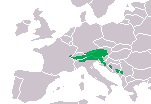Alpine Salamander
| Alpine salamander | |
|---|---|
 |
|
| Scientific classification | |
| Kingdom: | Animalia |
| Phylum: | Chordata |
| Class: | Amphibia |
| Order: | Caudata |
| Family: | Salamandridae |
| Genus: | Salamandra |
| Species: | S. atra |
| Binomial name | |
|
Salamandra atra Laurenti, 1768 |
|
 |
|
The alpine salamander (Salamandra atra) is a shiny black salamander found in the central, eastern and Dinaric Alps, at altitudes above 700 m (2,300 ft). The western Alps are inhabited by a similar species, Lanza's alpine salamander (Salamandra lanzai), in only one small area. No differences in length are seen between the sexes (9–14 cm (3.5–5.5 in)) and the sex ratio is 1:1. Their life expectancy is at least 10 years. Unlike other salamanders, whose larvae are developed in water, the alpine salamander is a fully terrestrial species. Capture-recapture methods suggest that the species is very stationary; 12 m (39 ft) was the maximum observed distance travelled by one individual during the summer season. About 120 individuals per hectare were counted in most suitable areas with >2000 individuals/ha also observed, suggesting that this rather cryptic species is quite abundant.
Genetic analysis suggests that the Corsican fire salamander (Salamandra corsica) is the closest related species, and the black-yellow coloration is an ancestral feature of alpine salamanders. Proposed colonization from south (Prealps) to Alps was carried out by the fully melanistic (derived feature) S. a. atra after the last retreat of the ice sheets.
Mating occurs on land, the male clasping the female at the fore legs, and the fertilization is internal. S. atra is an ovoviviparous amphibian, giving birth to two live young, or rarely three or four. They may measure as long as 50 mm (2.0 in) at birth, with the female measuring only 120 mm (4.7 in). The uterine eggs are large and numerous, but, as a rule, only one fully develops in each uterus, the embryo being nourished on the yolk of the other eggs, which more or less dissolve to form a large mass of nutrient matter. The embryo passes through three stages:
Generally, at altitudes of 650-1,000 m above sea level, a pregnancy lasts two years, and at altitudes of 1,400-1,700 m, the pregnancy lasts around three years (1,140 days).
...
Wikipedia

